This great article (and pictures) are courtesy of the USGS.
It has been published in the Sound Waves newsletter, a USGS publication.
The studies below have been made by an international team of scientists. There goal is to improve understanding of Tsunami hazards based on the tsunami deposits.
The earthquake was one of the five most powerful earthquakes recorded in the world since instrumental detection and record keeping began around 1900. The resulting tsunami flooded dozens of coastal cities, numerous ports, and the broad coastal plain around Sendai—the nearest major city to the earthquake, at a distance of 130 km (80 mi) from the epicenter. It is now estimated from aerial and satellite photography that an area of almost 500 km2 (200 mi2) was inundated by the tsunami.

Members of the May 2011 international tsunami survey team near their main survey transect. Sendai Airport is in the background. Survey team members and affiliations are (bottom row, left to right) Kazuhisa Goto (Chiba Institute of Technology, Japan), Shigehiro Fujino (University of Tsukuba, Japan), Witek Szczuciski (Adam Mickiewicz University, Poland), Yuichi Nishimura (Hokkaido University, Japan), Daisuke Sugawara (Tohoku University, Japan); (top row, left to right) Eko Yulianto (Indonesian Institute of Science, Indonesia), Rob Witter (Oregon Department of Geology and Mineral Industries, U.S.A.), Catherine Chagué-Goff (University of New South Wales, Australia), Dave Tappin (British Geological Survey, United Kingdom), Bruce Richmond (USGS, U.S.A.), and Bruce Jaffe (USGS, U.S.A.).
In May 2011, U.S. Geological Survey (USGS) scientists Bruce Jaffe and Bruce Richmond examined sediment deposited by the tsunami in and around Sendai as part of an international tsunami survey team organized by Japanese scientific cooperators. The 11 members of the team came from Japan, the United States, Australia, Poland, the United Kingdom, and Indonesia.
Survey teams try to enter tsunami-stricken areas as soon as possible after rescue and recovery work to document physical evidence of tsunami flow characteristics—such as debris in trees, high-water stains on buildings, and sedimentary deposits—before it is degraded or destroyed by natural forces or cleanup activities. Japanese researchers began this process during the second week after the earthquake; as the situation in Japan improved, they invited scientists from the international tsunami-research community to assist with gathering data from the large area affected by the tsunami.
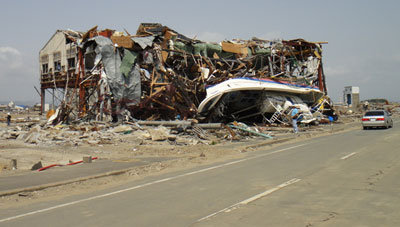
Building damaged by the tsunami in Yuriage. The tsunami flow depth here was approximately 8 m (26 ft).
The May reconnaissance survey focused on the characteristics of tsunami sediment deposits in the vicinity of Sendai Airport, with a specific emphasis on how these characteristics varied with tsunami speed and flow depth, topography (including microtopography), distance from the coast, urban and rural settings, land subsidence caused by the earthquake, and other aspects of natural and man-made features of the landscape. Among the information the scientists collected were data on water levels, flow directions, topography, sediment thickness, grain size, and sedimentary structures (patterns in the sediment produced by variations in such factors as the speed of the water from which the sediment was deposited and the composition and grain size of the sediment). They also collected sediment samples for microfossil, geochemical, and other analyses. The sedimentary evidence of the tsunami was complicated by liquefaction of some coastal-plain sediment during the earthquake and an extensive canal system that affected the movement of the tsunami waves and the sediment they carried.
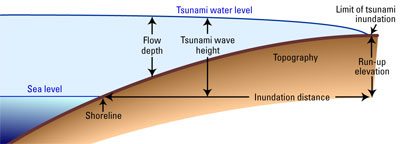
Diagram illustrating some of the terms used to describe tsunami characteristics.
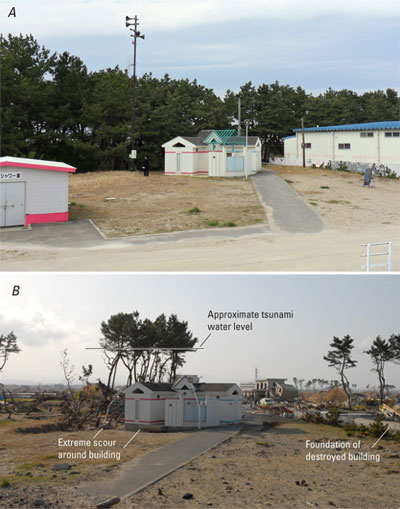
Photographs from Arahama beach on the Sendai coastal plain taken (A) before (April 11, 2010) and (B) after (May 4, 2011) the tsunami show damage to vegetation, landscape, and buildings. The buildings at far right and left were completely destroyed; all that remains are their foundations. The restroom building in the center survived the tsunami but underwent extreme scour and channeling around its base. The highest point of limb removal on the trees (trim line) shows the minimum water level of the tsunami in this area, which was measured as between 7 and 9 m (23 and 30 ft) above the ground (10-12 m [33-39 ft] above sea level).
This tsunami was particularly well documented in video footage shot by news agencies and citizens. The survey team took advantage of the video data by focusing their measurement and sampling efforts on areas where footage is available. One video they are using, posted at http://www.zimbio.com/Japan+Earthquake+2011/articles/PF8WtyjiF4c/Sendai+Tsunami+Video+Japan, shows the tsunami hitting the Sendai Airport. The team collected data along a transect near the airport where sand and mud were deposited more than 4 km inland—the longest post-tsunami transect in which tsunami deposits have been mapped in detail. The scientists will compare data from the sediment deposits with data from the video in hopes of relating characteristics of the deposits to the flow history of the tsunami. For example, they will compare the number and thickness of layers in the tsunami deposits with the number of waves and the flow speeds observed in the video.
The data collected in Japan, like data collected in field surveys after other recent tsunamis, will improve scientists' ability to recognize and interpret tsunami deposits from ancient events. Some of the scientists on the survey team will use the data to develop numerical models of tsunami sediment transport that can be applied to tsunami deposits in the geologic record to determine the characteristics—approximate size and speed, for example—of ancient tsunamis. Data from the Japanese study will also help scientists improve criteria for distinguishing tsunami deposits from large-storm deposits (see related Sound Waves article "Distinguishing Tsunami from Storm Deposits in the Geologic Record").
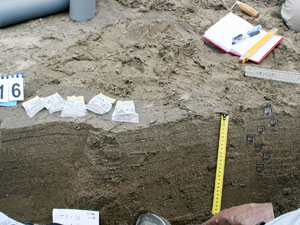
Wall of excavated trench showing the sedimentary structures of a tsunami deposit (mostly horizontal sand layers) and locations (rectangular markers on right) where sediment samples were collected for laboratory analyses.
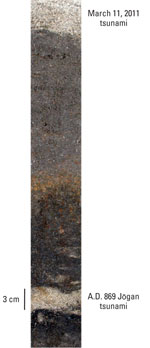 Additionally, the reconnaissance team will attempt to draw analogies between the March 11, 2011, tsunami deposits and deposits of predecessor events, such as the Jōgan tsunami, which struck the Sendai plain in A.D. 869 and was named after the emperor of the time. Japanese scientist Koji Minoura (Tohoku University) and colleagues published a paper in 2001 describing Jōgan tsunami sand deposits and two older sand deposits interpreted as evidence of earlier large tsunamis (Journal of Natural Disaster Science, v. 23, no. 2, p. 83-88, http://www.jsnds.org/contents/jnds/23_2.html). The ages of the two earlier tsunami deposits are A.D. 140-150 and 910-670 B.C. On the basis of this limited paleotsunami record for the Sendai coastal plain, the authors inferred a tsunami recurrence interval of 800-1,100 years.
Additionally, the reconnaissance team will attempt to draw analogies between the March 11, 2011, tsunami deposits and deposits of predecessor events, such as the Jōgan tsunami, which struck the Sendai plain in A.D. 869 and was named after the emperor of the time. Japanese scientist Koji Minoura (Tohoku University) and colleagues published a paper in 2001 describing Jōgan tsunami sand deposits and two older sand deposits interpreted as evidence of earlier large tsunamis (Journal of Natural Disaster Science, v. 23, no. 2, p. 83-88, http://www.jsnds.org/contents/jnds/23_2.html). The ages of the two earlier tsunami deposits are A.D. 140-150 and 910-670 B.C. On the basis of this limited paleotsunami record for the Sendai coastal plain, the authors inferred a tsunami recurrence interval of 800-1,100 years.
At the end of the paper they wrote, "More than 1,100 years have passed since the Jōgan tsunami and, given the reoccurrence interval, the possibility of a large tsunami striking the Sendai plain is high. Our numerical findings indicate that a tsunami similar to the Jōgan one would inundate the present coastal plain for about 2.5-3 km inland," a prediction that proved remarkably accurate.
Picture at right : Core collected by the survey team 1.6 km (1 mi) inland at Arahama on the Sendai coastal plain contains sandy deposits from the A.D. 869 Jōgan tsunami about 40 cm beneath the March 11, 2011, tsunami deposits. We chose the site on the basis of a report of the Jōgan tsunami deposits by Yuki Sawai (Active Fault Research Center) and colleagues in the Annual Report on Active Fault and Paleoearthquake Researches (2008, no. 8, p. 17-70, http://unit.aist.go.jp/actfault-eq/seika/h19seika/pdf/02.sawai.pdf [5.5 MB PDF]) and numerical modeling of Jōgan tsunami inundation by Kenji Satake (Active Fault Research Center) and colleagues (same volume, p. 71-89, http://unit.aist.go.jp/actfault-eq/seika/h19seika/pdf/03.satake.pdf [7.1 MB PDF]). The relative magnitudes of the Jōgan and 2011 tsunamis cannot be inferred from the thickness of each deposit, which is affected by local topography as well as sediment grain size and tsunami flow speed. [larger version]
Japan not only has the longest written record of historical tsunamis in the world, but it also has a vigorous paleotsunami research program designed to extend the tsunami record into the past and improve tsunami-hazard assessments. Examining field evidence of recent and historical tsunamis is critical to understanding these infrequent but catastrophic phenomena. The data collected recently in Japan by the international tsunami survey team will be used to develop tools for interpreting the geologic record of tsunamis. These tools can be applied to other areas where the same coastal hazard is present, such as the Pacific Northwest coast of the United States, and used to decrease future loss of life and property from tsunamis.